About us
JAXA Aviation helps to create a safer and more prosperous society with aeronautics-related research and development activities.
FLIGHT PATH No.24 | 2019 WINTER
Challenges of Young Researchers Round table discussions in pursuit of the challenges set in the Fourth Mid-to-long-term Plan
The FLIGHT PATH No. 24 features voices of young researchers who work at the forefront of research and development, playing major roles in turning ideas into technologies and interacting with industry players. A series of roundtable discussions introduces how young researchers take up their own challenges in each field (the En-Core Project, integrated simulation technology, supersonic aircraft, and electric aircraft) in pursuit of JAXA’s Fourth Mid-to-long-term Plan, which began in April 2018. Each session was facilitated by senior researchers who supervise them, and concluded with a comment from the directors.
The En-Core Project
Working on tighter project timelines
-
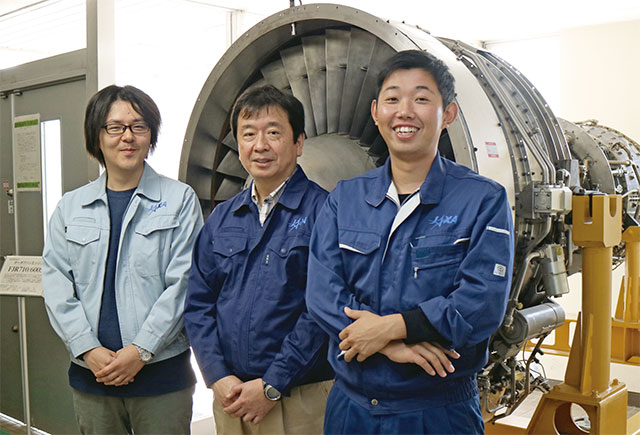
En-Core Project team
- Yamamoto: We first initiated the En-Core Pre-project in August 2018 and then transitioned to a full project in April 2019. It’s been eight months since then. What are your thoughts about this project so far?
Suzuki: Actually, I don’t have the sense that we are now working on a real project. It pretty much feels like I’m just doing the same research that I’ve always been doing. Of course, there’s the pressure that we now must produce concrete results, but that’s the same with other research as well.
Kato: I feel exactly the same way. I’ve always been studying combustors since before the project launch, so I don’t feel any different. I’m not feeling any pressure, but I do get the impression that the timelines for testing plans and so on have become tighter now that we have a clear target for completing the project.
Yamamoto: The En-Core Project builds on the combustor and turbine technologies developed in earlier research for green engine technology, so maybe that’s why you have that impression. Still, I’m sure there have been some changes after the project launch.
Suzuki: We have a bigger budget now for sure. In engine research, it costs a lot of money to build a prototype for testing. This is especially the case with the En-Core Project, which deals with components that withstand high temperatures and high pressure. Now that we have a bigger budget, applications for prototype fabrication are more likely to be approved. On the other hand, it also demands an aspect of systems engineering. As such, we must pay even more attention to the control of safety and quality.
Kato: The project launch has also had such benefits as the introduction of new facilities and the modification of existing facilities to make them compatible with high-temperature, high-pressure conditions. Thanks to these improvements, we are now able to conduct engine tests in an environment very close to the actual operating environment. Making the new and modified facilities available to external parties is, I think, also a mission that JAXA must fulfill.
Aiming for higher technology readiness levels
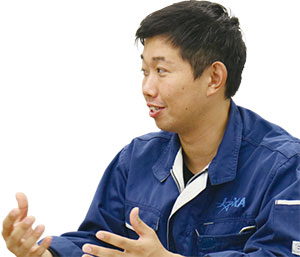
Researcher, En-Core Project team
Yamamoto: Unfortunately, we’ve seen no major research project involving Japanese engine technology since the FJR engine development project. One of the goals of the En-Core Project is to establish internationally competitive aircraft engine technologies.
Kato: That’s a very lofty goal technology-wise, but I don’t think it’s beyond reach if we utilize the technologies we’ve accumulated to date.
Suzuki: In terms of technology readiness levels (TRL), typical engine research at JAXA aims at around TRL 3 or 4, but the En-Core Project aims at TRL 4 or 5, which is just a step away from engine demonstration. Manufacturers won’t pay attention to technologies under that level. Working with high-temperature, high-pressure components is really tough, but I wish to steadily move the project forward.
Yamamoto: The En-Core Project offers more opportunities to interact with manufacturers than any other department at JAXA’s Aviation Technology Directorate. Have you ever felt any difference between JAXA and a private sector company?
Suzuki: My impression is that manufacturers want to do research that produces practical results, something that can be applied in society right away. While JAXA has that aspect as well, we put greater emphasis on doing research that looks farther ahead. When interacting with people from the private sector, I sometimes feel that gap.
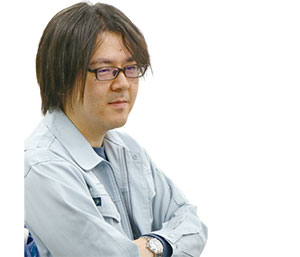
Associate Senior Researcher, En-Core Project team
Doing individual research with an eye to the project
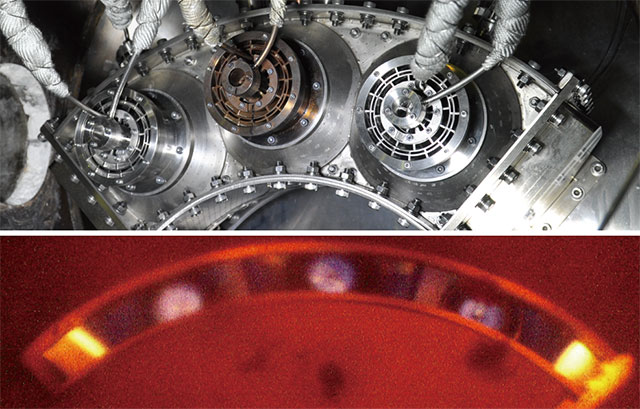
Combustion test (lower image) inside a combustor (upper image)
Yamamoto: Both of you are involved in the entire En-Core Project, but have you been able to pursue your own interests or do your own research?
Kato: Yes. I manage to find the time to do my own research as well. The theme is establishing a laser measurement technique in an actual engine environment (under high-temperature, high-pressure conditions). Under these conditions, the refractive index of light changes because of a steep temperature gradient between the flame and ambient gas. For this reason, only blurry images can be obtained inside a combustor. I’d like to develop a technique that can capture accurate images under these conditions, and use the information obtained for the project’s technology development.
Suzuki: I am assigned tasks by three departments including the En-Core Project, so I have no time to do my own research. I’d rather do my own research, but I have to do those assigned tasks. There are tons of things I like to do, but I just don’t have the time to do them right now.
Yamamoto: I know how busy you are, and I’ve seen how you struggle to carve out time for your own work. The first two to three years in a project are spent on research and development of component technologies. After that, we move to a phase centered on demonstration. I hope you can leverage your own research and that we can move the project forward together.
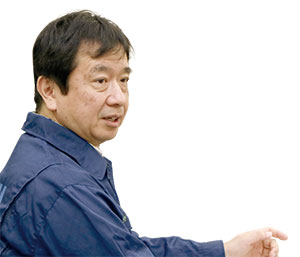
Sub-manager, En-Core Project team
“I was relieved to hear that the direction of individual research targets and the project’s goals are not far apart. I hope the members see this project as an opportunity to strengthen cooperative relationships with partner companies and discover seeds of their future research.”
YAMANE Takashi
Project Manager, En-Core Project team